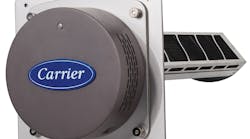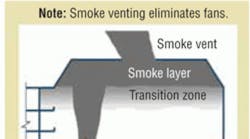Sustainable smoke-control systems minimize or eliminate components found in conventional smoke-control systems—primarily, fans and ductwork. As a result, they tend to consume less power. This article discusses sustainable smoke-control systems—atrium smoke-control systems and pressurization smoke-control systems in particular.
Tenability Systems
Tenability systems maintain a tenable environment during evacuation (or relocation to a safe place in a building, which is not nearly as common as evacuation and, thus, is not discussed in this article). NFPA 92, Standard for Smoke Control Systems, defines a tenable environment as one in which smoke and heat are restricted to a non-life-threatening level.
Analysis of tenability systems is much more sophisticated than analysis of conventional smoke-control systems, as it includes smoke-transport, tenability, and evacuation calculations. Smoke-transport calculations determine the properties of smoke throughout a building as a function of time. Tenability calculations evaluate the impact of smoke exposure on people. Evacuation calculations estimate the time needed to exit a building.
Smoke-transport calculations. For many applications, smoke transport can be simulated with computational fluid dynamics (CFD). CFD software divides a space into a large number of cells and solves governing equations for smoke velocity and properties.
Fire Dynamics Simulator (FDS) is a CFD model developed by the National Institute of Standards and Technology (NIST) for fire-protection applications. FDS is available from NIST at no cost (for more information and to download, go to http://1.usa.gov/FDS-SMV).
CFD is not appropriate for smoke flow in large buildings. Approximate simulations, however, are achievable with CONTAM. CONTAM is a network model also available from NIST at no cost (for more information and to download, go to http://1.usa.gov/CONTAM).
CFD is capable of realistic and detailed simulations, but is time-consuming. For example, a simulation of an atrium smoke-control system commonly takes 18 to 36 hr.
Tenability calculations. The direct threats to human life presented by flames and smoke are toxic gases, heat, and thermal radiation. In thick smoke, people see poorly and walk slowly or become disorientated, which prolongs exposure to smoke. Falls from balconies are an additional threat associated with reduced visibility. The impact of these threats can be analyzed.
Evacuation calculations. Evacuation time consists of pre-movement time and movement time. Pre-movement time is the period after occupants become aware of a fire during which they think about what to do. Often, they continue their activities until the urgency of the situation becomes obvious. After they recognize the need to evacuate, they often take additional time to find a coat, gather belongings, etc. Pre-movement time can be as long as movement time or much longer. Calculations of evacuation time must include a reasonable allowance for pre-movement time.
Atrium Smoke Control
In the United States, the most common approach to atrium smoke control is steady smoke exhaust. The conventional approach is intended to maintain the smoke layer above occupants’ heads during evacuation. The capacity of an exhaust fan depends on the size of the design fire and the floor-to-ceiling height of the atrium. For a three-story atrium, smoke exhaust can be 100,000 cfm or more. Makeup air is provided by fans or from the outside through openings at about 85 to 95 percent of exhaust air.
Smoke venting. Smoke venting can eliminate the need for smoke exhaust fans and associated ductwork. This approach is not common in the United States, but has been proven in Europe, Australia, New Zealand, and Japan. Natural venting consists of discharging smoke through one or more vents in the ceiling and providing makeup air from the outdoors through vents in the walls (Figure 1). The buoyancy of the smoke layer causes smoke to flow out through the ceiling vent(s) and makeup air to flow in through the wall vents.
During summer, when the vents open, there is a tendency for hot outdoor air to flow down through the ceiling vent(s), dispersing smoke in the atrium. After a few minutes, this downward flow stops, and the intended atrium venting shown in Figure 1 is established.
CFD modeling can be used to simulate summer transient downward flow and evaluate tenability in an atrium.
Conventional analysis of atrium smoke control assumes a uniform smoke layer, with a sharp transition between the smoke layer and the air below. As shown in Figure 1, however, there is a gradual transition layer. CFD modeling is capable of simulating this transition. Wind is a major concern with smoke venting; CFD can simulate wind effects.
Smoke filling. Smoke filling is the simplest form of smoke control for atria and other large-volume spaces. It entails allowing smoke to fill a space without smoke exhaust or any other smoke removal. For a conventional smoke-filling system to keep smoke away from occupants during evacuation, filling time must be greater than the time needed for evacuation.
With a tenability smoke-filling system, occupants can come into contact with smoke provided a tenable environment is maintained during evacuation. This means filling time does not necessarily need to be greater than evacuation time. Depending on the heat-release rate of the design fire, the location of the design fire, and the kinds of materials burned, a tenable environment can be maintained for some time after an atrium fills with smoke.
Knowledge of smoke plumes is essential to understanding tenability smoke-filling systems. Considerable research on plumes has been conducted.1,2,3 When a smoke plume rises above a fire, it entrains air from the surroundings. This means the mass flow of the plume increases with height. Temperature and contaminant concentration, meanwhile, decrease with height.
When a plume reaches the ceiling, the flow turns, forming a jet under the ceiling, as shown in Figure 2a. The arrows indicate air being entrained in the plume. If the ceiling is sufficiently high, the space should be tenable.
Figure 2b shows an atrium partially filled with smoke. Below the smoke layer, air is entrained in the plume. In the smoke layer, smoke is entrained in the plume. Figure 2c shows the atrium filled with smoke, with only smoke entrained in the plume. Contaminant concentration will increase until the atrium becomes untenable. CFD modeling is recommended as part of atrium-filling tenability analysis.
Alternatives to Pressurization
The most common pressurization smoke-control systems are pressurized stairwells, pressurized elevators, and zoned smoke control. Alternatives to these systems can take advantage of passive compartmentation and/or dilution to reduce or eliminate fans and ductwork.
Stairwell ventilation. An alternative to stairwell pressurization, stairwell ventilation is intended to protect stairwells from small amounts of smoke that leak through gaps around closed doors. This is accomplished by supplying air to and exhausting it from stairwells. The idea is to dilute products of combustion so that a tenable environment is maintained. This approach has the potential to provide smoke protection for very tall stairwells in very complex buildings.
Stairwell ventilation systems can be analyzed using CONTAM and CFD.4 Gross flows in a building can be analyzed using CONTAM. To analyze flows inside of a stairwell, one needs to model only a few floors of the stairwell using CFD. Smoke concentration and tenability on stairwell landings on fire floors are of particular importance. Figure 3a shows how smoke can fill a stairwell that is not ventilated, while figures 3b and 3c show how ventilation can provide protection with and without people.
Conclusion
Smoke-control systems can be thought of as sustainable in that they minimize the extent of damage to building components and contents. Smoke-control systems also can be thought of as sustainable by minimizing or eliminating components used in conventional systems. Sustainable smoke-control systems used in place of code-mandated systems need to provide protection at least equivalent to that provided by the systems they replace. The extent to which sustainable smoke-control systems can be developed depends on the ingenuity, creativity, and knowledge of design teams.
References
1) Cetegan, B.M., Zukoski, E.E., & Kubota, T. (1982). Entrainment and flame geometry of fire plumes. PhD thesis of Cetegan. Pasadena, CA: California Institute of Technology.
2) McCaffrey, B.J. (1983). Momentum implications for buoyant diffusion flames. Combustion and Flame, 52, 149–167.
3) Heskestad, G. (1984). Engineering relations for fire plumes. Fire Safety Journal, 7, 25–32.
4) Klote, J.H. (2011). Stairwell smoke control by ventilation. ASHRAE Transactions, 117, Part 1.
A longtime member of HPAC Engineering’s Editorial Advisory Board, John H. Klote, PE, DSc, developed and conducts a series of smoke-control seminars for the Society of Fire Protection Engineers. For 19 years, he conducted fire research for the National Institute of Standards and Technology. He is a co-author of the books “Principles of Smoke Management,” “A Guide to Smoke Control in the 2006 IBC,” and the recently published “Handbook of Smoke Control Engineering” (see sidebar).
Did you find this article useful? Send comments and suggestions to Executive Editor Scott Arnold at [email protected].
SIDEBAR: SMOKE-CONTROL HANDBOOK AVAILABLE
John H. Klote, PE, DSc, is the co-author of a new book on smoke-control technology.
Published by ASHRAE, along with the Society of Fire Protection Engineers, the International Code Council, and the National Fire Protection Association, and co-written by James A. Milke, Paul G. Turnbull, Ahmed Kashef, and Michael J. Ferreira, the 512-page "Handbook of Smoke Control Engineering" covers fundamental concepts, smoke-control systems, and methods of analysis and includes results of the latest research and engineering advances in smoke-control technology. It is in dual units and includes many example calculations.
The cost of "Handbook of Smoke Control Engineering" is $109 for ASHRAE members and $129 for non-members in print or PDF format. To purchase, go to http://bit.ly/Smoke_Control_book.












